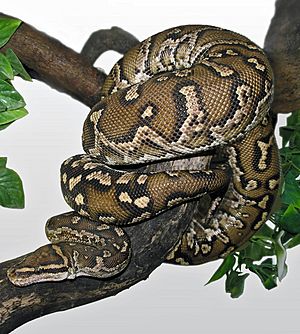Python anchietae facts for kids
Quick facts for kids Python anchietae |
|
|---|---|
 |
|
| Conservation status | |
| Scientific classification | |
| Genus: |
Python
|
| Species: |
anchietae
|
| Synonyms | |
|
|
The Angolan python (also called Anchieta's dwarf python) is a special type of python. It lives only in southern Africa. This snake is closely related to the ball python found in western Africa. There are no different types (subspecies) of the Angolan python. It was named after a Portuguese explorer and nature expert, José Alberto de Oliveira Anchieta. Like all pythons, it is not venomous. This means it does not have poison.
Contents
About the Angolan Python
What Does It Look Like?
The Angolan python can grow up to 183 cm (6 feet) long. This measurement includes its tail. Its body color can be reddish-brown, brown, or almost black. It has white or cream-colored stripes and spots that are not regular. The underside of its body is yellowish.
This snake is quite rare. It is not often seen in the wild or in zoos. The Angolan python is the only python that has scales on its head that look like small beads. It also has special "heat-sensitive pits" on its upper lip. There are five of these pits on each side of its head. These pits help the snake find warm-blooded prey. Its back scales are smooth and are arranged in 57 to 61 rows.
Where Does It Live?
The Angolan python lives in Africa. You can find it in southern Angola and northern Namibia. Its natural home is in rocky areas. It likes places with rocks scattered around in open brush or grasslands.
This snake is active during the day. It finds shelter in small caves, under rocky overhangs, and in cracks in the rocks.
Behavior and Life Cycle
The Angolan python acts a lot like its close relative, the ball python. If it feels threatened, it might hiss. However, this is usually just a way to scare off danger. It is mostly bluff.
Its diet includes small mammals and birds. The Angolan python is oviparous. This means the female snake lays eggs. They usually lay small groups of four or five eggs at a time. Scientists are not sure if the mother snake "incubates" her eggs. Many pythons keep their eggs warm until they hatch. When the baby pythons hatch, they are about 43–46 cm (17-18 inches) long.
Angolan Pythons in Captivity
It is very rare to find Angolan pythons in captivity. This is partly because of a long civil war that happened in Angola. Even though the war is over, it is still hard to catch these snakes. This makes them very special to snake collectors.
People who own these snakes often compare them to ball pythons. They have similar personalities and need similar care.




